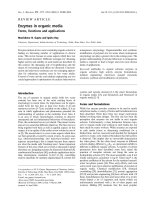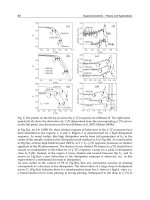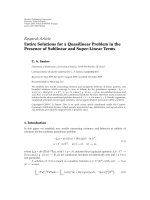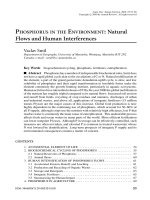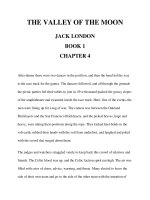Enzymes in the Environment: Activity, Ecology and Applications - Chapter 4 potx
Bạn đang xem bản rút gọn của tài liệu. Xem và tải ngay bản đầy đủ của tài liệu tại đây (464.61 KB, 15 trang )
4
Enzymesand Microorganisms
in theRhizosphere
DavidC.Naseby
Universityof Hertfordshire,Hatfield,Hertfordshire,England
JamesM.Lynch
UniversityofSurrey,Guildford,Surrey,England
I.INTRODUCTION
Althoughthetermrhizosphere wascoinedbyHiltner(1)todescribespecificallytheinter-
actionbetweentherootsoflegumes andbacteria,theusageoftheterm hasbroadened.
Todayweconsidertherhizosphere tobethezoneofinfluenceofall plantrootsystems,
anditincludesthevariouscelllayersoftherootitself(the endorhizosphere),whichmicro-
organismscancolonize;therootsurface(therhizoplane);andthe regionsurroundingthe
root(theectorhizosphere).Therehas beensteadyprogressinourunderstanding ofthe
rhizosphereduringthelast 100yearsandanincreasingrealizationthatitcanhavemany
influencesoncrop productivity(Table1).However,therehasbeen a sudden increase in
interest and investment in rhizosphere research in the past few years. This is largely due
to the growth of biotechnology in relation to agriculture and, in particular, our increasing
ability to manipulate plants by using recombinant deoxyribonucleic acid (DNA). Even
with the genetic information of the plant modified, however, there will still be a highly
influential microbial population associated with the roots. Therefore, the possibility exists
that the balance between beneficial and harmful rhizosphere microorganisms might be
improved not only by modification of the plant genotype but also by inoculation with
useful and compatible microorganisms. The source of these useful bacteria and fungi could
be either other soils and rhizospheres, hence amplifying the natural population, or introduc-
tion of ‘‘foreign’’ organisms that have been genetically modified to elevate their useful
properties and/or increase their competence to colonize the rhizosphere. Given current
public opinion, the latter is unlikely in the near future.
The general properties of rhizospheres have been described in several books (2–5).
Not surprisingly two highly integrated microbe-plant root associations have attracted the
most intense study. The first of these involves the activities of symbiotic dinitrogen-fixing
bacteria. These bacteria express the nitrogenase enzyme complex and have received much
attention in recent years as the various nif genes have been fully characterized (6–8). The
other major group of microbe-plant symbionts in soil, the mycorrhiza, which promote the
Copyright © 2002 Marcel Dekker, Inc.
Table1InfluencesofRhizosphereMicroorganisms
onCropProductivity
BeneficialeffectsHarmfuleffects
Nutrientandwaterup-Nutrientcompetition
takeenhancement
DinitrogenfixationDenitrification
PhytohormoneproductionPhytotoxinproduction
SymbiosisPathogenesis
DiseaseandpestcontrolOxygendepletion
SoilstabilizationDegradationofsoilstructure
solubilizationanduptakeofphosphorusandotherplantnutrientsbyavarietyofbiotic
andabioticmechanisms(9,10),havealsobeenstudiedextensively(seeChapter5).
Rhizosphereenzymologyhasbeenparticularlyexploitedinbiomonitoringandim-
pactanalysis.Mostattemptstomonitortheeffectsofmicroorganismsintherhizosphere
havecenteredontheenumerationofspecificpopulations.However,forasignificantper-
turbationtobemeasured,changesofbetween100%and300%arenecessarytoproduce
asignificantimpact.Standardpopulationmeasurements,assessingthesurvivalanddis-
seminationandeffectontotalindigenouspopulations,donotgiveanindicationofthe
functioningoftheecosystem.Thereisverylittleliteratureregardingthefunctionalimpact
ofmicrobesonecosystems,forinstance,theeffectuponnutrientcycling.Inthisreview
functionalmethodologyisassessedforitsapplicationasanindicatoroftheimpactonthe
soilecosystem.In1997arangeofsoilenzymeassayswasusedasanalternativeto,or
incombinationwith,populationmeasurements(34).Theseappearquitesensitive,asim-
pactsoflessthan20%onecosystemdisturbancecouldbesignificantlydetected.Enzyme
functionsofthiskindintherhizospherearepotentiallyexploitableinprocessessuchas
biocontrolandbioremediation,andthesearethemajorfocusofthisreview.
II.SOILENZYMESASFUNCTIONALINDICATORS
Soilenzymemeasurementsareextremelyimportantinassessingthestatusorthecondition
ofthesoilenvironment.Thisisbecauseenzymesareessentialtothecyclingofnutrients
insoilandarethuscriticaltotheavailabilityofnutrientstobothmicrobiotaandplants.
Frequentlyenzymesareregulatedandexternalizedasaresponsetoexogenoussoilcondi-
tions,suchasphosphatasesecretionduetophosphatedeficiency(37,38)orplantchitinase
asaresultoffungalorinsectattack(11),andarethusgoodindicatorsofchangeor
perturbation.Thesecondexampleshowsthatsoilenzymesarerespondingtothefunctional
statusofthebiota,inadditiontothechemicalenvironmentasmeasuredbynutrientcycle
measurements(Fig.1).Manyextracellularenzymesareadsorbedto,complexedwith,or
entrapped within soil clays and humics (12). As a consequence, they may have a long-
term stability and thus can provide an indication of the history of the sample and not just
a snapshot from the time of sampling. However, as Figure 1 indicates, the ultimate assess-
ment of the effect of the gene products is the plant bioassay (especially if the human
perspective is considered), by which productivity and nutritional values are measured.
Many enzymes are secreted actively into the soil environment by microbes and by
Copyright © 2002 Marcel Dekker, Inc.
Figure 1 A sequence illustrating the impact of a rhizosphere microorganism. The first functional
product of the deoxyribonucleic acid (DNA) that can be monitored is messenger ribonucleic acid
(RNA) which produces the gene products (enzymes and metabolites).
plant roots and function by solubilizing nutrients; others are released into the soil by the
lysis of microbial and plant cells. As mentioned, these extracellular enzymes often are
immobilized by soil components and thus protected from degradation. There are several
mechanisms by which enzymes can become immobilized in the soil, including adsorption
on and within clay particles and organic matter, chemical complexing with organic matter,
and entrapment within microbial polymers or soil aggregates (13). Once immobilized, the
enzymes still may be active in the soil, but at variably reduced rates caused by factors such
as steric hindrance, diffusional resistance, blocking of active sites, electrostatic effects, or
reversible denaturation (14).
If soil enzymes can be assessed and shown to vary with different soil treatments, then
such measurements could be useful indicators of perturbation and of changes in functional
diversity. Land management practices have been shown to have a significant influence on
soil enzymes; for example, it has been demonstrated that cultivation can have a large
effect on the soil arylsulfatase activity (15). Thus, long-term grassland soil cultivation (69
years) caused a 66% reduction in arylsulfatase activity, whereas cultivation of a forest
soil for 47 years resulted in an 88% decrease. Large differences in sulfatase activity were
found between a cultivated forest soil (63% decrease) and a similar forest soil that had
been left fallow for 5 years (30% decrease).
In the same study (15) changes in the kinetic properties of the soil sulfatases were
investigated. After cultivation, a reduction was found in the V
max
(74% in the grassland
Copyright © 2002 Marcel Dekker, Inc.
soil and 90% in the forest soil) and the Michaelis constant (K
m
), which decreased with
the duration (years) of cultivation. Variations in K
m
values obtained from the forest and
grassland soils suggest that the origins of the enzymes were different in the two soils.
Therefore, such kinetic studies can be a good indicator of differences in soil enzymes
with soil type and under very different soil management methods and may be sensitive
enough to be applied to assessing the changes caused by less drastic soil treatments. Over-
all, sulfatase activity was extremely sensitive to the soil management system and sulfatase
may be one enzyme that is a good indicator of small-scale perturbations.
A second example of the effect of land management practices on soil enzyme activi-
ties is provided by the work of Jordan and associates (16). They evaluated microbial
measurements (including acid and alkaline phosphatase activities) as indicators of soil
quality in long-term cropping practices in historical fields. Differences in phosphatase
activities among soils could be related to land management practices and soil properties
(especially organic matter). For example, acid phosphatase activity was 150% higher in
soil under continuous corn with no-till and receiving full fertility treatment than under
conventional tillage with no fertility treatment. Alkaline phosphatase activity was 50%
higher in soil under continuous corn with full fertility treatment than without the fertility
treatment. This study again shows that soil enzyme activities can change greatly after the
large perturbations caused by soil management practices and thus have great potential as
a general indicator of smaller-scale perturbation.
In another study concentrating on the impact of crop and land management systems
on soil enzyme activities from a coconut-based multistoried cropping system (17), de-
creases in urease and an unspecified phosphatase (but not dehydrogenase) with increasing
depth in rhizosphere soil were found. Differences were found also in urease and phospha-
tase with the different crops grown. Cocoa and pineapple produced contrasting results to
the coconut rhizosphere (higher phosphatase activity in the coconut rhizosphere and higher
urease activity with multistoried systems over a coconut monocrop). Depth and crop sys-
tem appear to have a large influence on rhizosphere enzyme activities.
The effect of pesticides on the activity of various soil enzymes has been investigated
by a number of researchers (18,19). A prime example of this is the work of Satpathy and
Behera (20), who examined the effect of malathion on cellulase, protease, urease, and
phosphatase activities in a tropical grassland soil. They found that the significantly de-
pressed cellulase and protease activity recovered to almost the same level as that of the
control 21 days after malathion application, whereas urease and, to a larger extent, phos-
phatase activities did not show such a rapid recovery.
A similar situation to the addition of pesticides to soil is the input of inorganic
pollutants, which can have major effects not just on enzymes but on the whole soil ecosys-
tem. Decreases in cellulase activity were found with increasing sulfur, nitrogen, and heavy
metal pollution (21). The reduction in cellulase activity was correlated with a decrease in
respiration along the same pollution gradient. However, cellulase activity was a more
precise indicator of the level of pollution than were respiration measurements.
III. MICROBIAL INOCULATION AND SOIL ENZYME ACTIVITIES
A proposed target for genetic manipulation is the insertion or enhancement of genes encod-
ing specific enzymes; a prime candidate for this is chitinase because of its postulated role
in the biocontrol of fungal crop pathogens. Ridout and colleagues (22) investigated the
Copyright © 2002 Marcel Dekker, Inc.
protein production induced in a Trichoderma species when cell wall fragments of the crop
plant pathogen Rhizoctonia solani (to which the Trichoderma species was an antagonist)
were used as the sole carbon source. Both β-glucanase and chitinase were found to be
important components of the inducible extracellular proteins analyzed by electrophoretic
profiles. The sequence of chitin degradation (and pathogen biocontrol) was extremely
complex with several other inducible enzymes probably involved.
Much of the interest in the enzymology of Trichoderma sp. pathogen biocontrol has
focused on chitinase and 1,3-β-d-glucanase, although proteases could be involved (22,23).
Furthermore, many authors have suggested that chitinase may be the most important en-
zyme in biocontrol by Trichoderma sp., and because the enzyme can be purified and
characterized readily (24), it has been a good target for transformation (25). As yet, how-
ever, it has not been possible to demonstrate that introduction of the gene into a nonproduc-
ing strain increases biocontrol potential. However, much has been learned about gene
expression and its regulation during mycoparasitism of fungal pathogens by Trichoderma
sp. by using gene probes and markers (26–28).
Other rhizosphere microorganisms produce chitinase and exert biocontrol effects;
notable among these are the actinomycetes (29). To detect these chitinase genes, a chiA
DNA probe is available (30). It should be remembered, however, that detection of a gene
does not necessarily mean the gene will be expressed, and therefore, in the example here,
a positive signal from the probe does not necessarily mean that chitinase is expressed—
merely that the genotype or potential exists.
The situation in which genes encoding enzymes (especially extracellular) are the
target of manipulation gives an added emphasis to the use of soil enzyme activities as a
measure of perturbations caused by the introduction of such microorganisms into the soil
and rhizosphere. In an attempt to understand the effect of manipulated enzyme production
on a soil microorganism, one study involved rhizosphere growth of Pseudomonas solana-
cearum, which was genetically altered in extracellular enzyme production (endopolygalac-
touronase A and endoglucanase) (31). The strains that had been enhanced in terms of
enzyme production had greatly reduced fitness in the rhizosphere. However, the authors
did not use the opportunity to study the effect on soil extracellular enzyme activity with
the inoculation of strains with such functional modifications.
There are few data regarding the use of soil enzymes as a measure of perturbations
caused by the introduction of extraneous microorganisms into the soil or the rhizosphere,
and much of the available information is contradictory. Doyle and Stotzky (32) evaluated
a number of enzymes, including arylsulfatase, dehydrogenase, and acid and alkaline phos-
phatase, for the detection of changes in the microbial ecological characteristics of the soil
caused by the introduction of Escherichia coli but found no consistent significant differ-
ences in any of the enzyme activities. It must be noted, however, that this experiment (as
with a great many others) did not reflect ‘‘ecologically relevant’’ conditions, as the strains
used were not natural soil organisms and the experiment was conducted in bulk soil in
the absence of plants.
Commercial inoculants often are designed to live and perform functions in the rhizo-
sphere and respond to root exudates (a major source of carbon and nutrients). Therefore,
it is not surprising that the work of Doyle and Stotzky (32) found few effects upon enzyme
activities. The survival and metabolic activity of the E. coli strain were likely to be low
since there was no additional substrate and indigenous carbon would have been unsuitable
or utilized by the preexisting microflora. Furthermore, E. coli is not a soil organism
and is unlikely to establish a viable population after introduction into soil. In contrast,
Copyright © 2002 Marcel Dekker, Inc.
Mawdsley and Burns (33) introduced a soil Flavobacterium species into the rhizosphere
of wheat. They found that the microbial inoculant caused increased α-galactosidase, β-
galactosidase, α-glucosidase, and β-glucosidase activities in the more ecologically and
agriculturally relevant conditions of the wheat rhizosphere.
A number of simple enzyme assays for the detection of perturbations resulting from
different soil treatments, including the introduction of a modified Pseudomonas fluo-
rescens SBW25 strain and substrate amendments, have been designed (34). The aim of
the experiment was to deduce whether these assays were sensitive enough to measure
perturbations caused by microbial inoculation. Specific attention was paid to the validation
of soil biochemical techniques as a method of monitoring the effects of inoculation. Differ-
ences in wheat rhizosphere soil biomass (measured by adenosine triphosphate [ATP] con-
tent) and several key soil enzyme activities with microbial inoculation and/or modified
conditions (addition of the enzyme substrates, chitin, urea, and glycerophosphate, to soil)
were measured.
Microbial biomass, as well as enzyme activities (with the exception of that of acid
phosphate), decreased with depth. The addition of a substrate mixture of urea, colloidal
chitin, and glycerophosphate to soil significantly increased N-acetyl glucosaminidase, chi-
tobiosidase, arylsulfatase, and urease activities but did not cause a change in acid and
alkaline phosphatase and phosphodiesterase activities. Inoculation of wheat seeds with P.
fluorescens resulted in significant increases in rhizosphere chitobiosidase and urease activi-
ties at 5- to 20-cm depth and a significant decrease in alkaline phosphatase activity. The
0- to 5-cm depth activities were unchanged. Inoculation with P. fluorescens in combination
with the substrate mixture had effects opposite to those of treatments without substrate
mix addition: chitobiosidase, arylsulfatase, and urease activities were significantly lower
and alkaline phosphatase was significantly higher at the 5- to 20-cm depth interval with
inoculation of bacteria. Biomass values for the combined bacteria and substrate mix treat-
ment were significantly higher than for the substrate mix alone treatment.
IV. SOIL ENZYME ACTIVITIES AND GENETICALLY
MODIFIED ORGANISMS
Naseby and Lynch (35) used enzymatic analysis, combined with microbial population
measurements and other soil indicators, to investigate the effect of wild-type and geneti-
cally modified microbes in the rhizosphere. They studied whether the impact of a P. fluo-
rescens strain, a genetically modified microbe (GMM) altered for kanamycin resistance
and lactose utilization, could be enhanced by adding lactose and kanamycin to the soil
(prior to/subsequent to amendment). Lactose addition decreased the shoot-to-root ratio
and both soil amendments increased the populations of total culturable bacteria and the
inoculated GMM. Only kanamycin perturbed the bacterial community dynamics, causing
a shift toward slower-growing organisms. The community structure with the GMM inocu-
lum, in the presence of kanamycin, showed the only impact of the GMM compared to
that the wild-type inoculum. The shift toward K strategists (i.e., slower-growing organ-
isms) found in the other kanamycin-amended treatments was reversed with the GMM
inoculation. Lactose amendment increased acid and alkaline phosphatase, phosphodiester-
ase, and carbon cycle enzyme activities, whereas the kanamycin addition affected only
the alkaline phosphatase and phosphodiesterase activities. None of the soil enzyme activi-
ties was affected by the GMM under any of the soil amendments.
Copyright © 2002 Marcel Dekker, Inc.
Althoughthisstudyinvolvedtheuseofageneticallymodifiedmicrobe,themodifi-
cationswerenotintendedtohaveafunctionalimpact;theywereinsertedasgeneticmark-
ers.Asecondstudycomparingtheeffectofthesamegeneticallymarkedstraintothatof
afunctionallymodifiedstrainshowedeffectsthataremoreinteresting(36).Theaimof
thisworkwastodeterminetheimpactintherhizosphereofwildtypealongwithfunction-
allyandnonfunctionallymodifiedPseudomonasfluorescensstrains.Thewild-typeF113
straincarriedageneencodingtheproductionoftheantibiotic2,4-diacetylphloroglucinol
(DAPG),usefulinplantdiseasecontrol,andwasmarkedwithalacZYgenecassette.The
firstmodifiedstrainwasafunctionalmodificationofstrainF113withrepressedproduction
ofDAPG,creatingtheDAPGnegativestrainF113G22.Thesecondpairedcomparison
wasanonfunctionalmodificationofwild-type(unmarked)strainSBW25,constructedto
carrymarkergenesonly,creatingstrainSBW25EeZY-6KX.
Significantperturbationswererecordedintheindigenousbacterialpopulationstruc-
ture;theF113(DAPGϩ)straincausedashifttowardslower-growingcolonies(Kstrate-
gists)comparedwiththenon-antibiotic-producingderivative(F113G22)andSBW25
strains.TheDAPGϩstrainalsosignificantlyreduced,incomparisonwiththoseofthe
otherinocula,thetotalPseudomonassp.populations,butdidnotaffectthetotalmicrobial
populations.ThesurvivalofF113andF113G22wasanorderofmagnitudelowerthan
thatoftheSBW25strains.TheDAPGϩstraincausedasignificantdecreaseintheshoot-
to-rootratioincomparisontothatofthecontrolandotherinoculants,indicatingplant
stress.F113increasedsoilalkalinephosphatase,phosphodiesterase,andarylsulfataseac-
tivities(Table2)comparedtothoseofthecontrols.Theotherinoculareducedthesame
enzyme activities when compared to the control. In contrast, the β-glucosidase, β-galactos-
idase, and N-acetyl glucosaminidase activities decreased with the inoculation of the
DAPGϩstrain(Table1).Theseresultsindicatethatsoilenzymesaresensitivetothe
impact of GMM inoculation.
Increased available (soluble) inorganic phosphate is known to decrease soil phospha-
tase activity (37,38). Therefore, the F113 (DAPGϩ) strain must have caused a decrease
in the available phosphate, thus causing an overall increase in activity. The decrease in
available P may have taken the form of an increase in the available carbon in the rhizo-
sphere (by stimulation of root exudation or leakage, as there was a decrease in the shoot/
root ratio). Other studies have highlighted changes in root exudation caused by biocontrol
P. fluorescens strains (39). Therefore, increasing the ratio of C to P available would in-
crease the microbial P demand.
Inverse trends were found with the C and N cycle enzymes in comparison to the
general trend found in the P and S cycle enzymes. The F113 (DAPGϩ) strain was associ-
ated with the lowest acid β-galactosidase activity, which was significantly lower than that
of the SBW25 WT treatment. The F113 (DAPGϩ) strain produced the lowest β-glucosi-
dase activity, which was significantly smaller than that of the control, the SBW25 WT,
and the F113 G22 treatments, which all had similar activities. As with the β-galactosidase
and β-glucosidase activities the F113 (DAPGϩ) strain produced the lowest N-acetyl glu-
cosaminidase activity. This was a significantly lower activity than that of the control, the
SBW25 WT, and the F113 G22 treatments, which all had comparable activities. All three
carbon cycle enzyme activities, therefore, also indicate an increase in carbon availability.
Subsequent work with a genetically modified DAPG overproducer found effects similar
to those of the wild-type DAPG producer (40).
Further, the carbon fractions in the rhizosphere of pea plants inoculated with strains
F113 and F113 G22 were examined (41). Both strains significantly increased the water-
Copyright © 2002 Marcel Dekker, Inc.
Table 2 Soil Enzyme Activities in the Rhizosphere of Pea Plants Inoculated with Wild-Type and Genetically Modified Pseudomonas fluorescens Strains
Acid Alkaline Acid
Treatment
a
phosphatase
b
phosphatase
b
Phosphodiesterase
b
Arylsulfatase
b
β-galactosidase
b
β-glucosidase
b
NAGase
b
Control 7.91ab Ϯ 0.40 1.23bc Ϯ 0.15 0.11a Ϯ 0.018 0.09a Ϯ 0.01 0.52ab Ϯ 0.04 1.02b Ϯ 0.10 0.32b Ϯ 0.03
F113 G22 8.24ab Ϯ 0.69 0.70a Ϯ 0.16 0.09a Ϯ 0.03 0.08a Ϯ 0.02 0.1ab Ϯ 0.05 1.02b Ϯ 0.14 0.29b Ϯ 0.03
F113 7.06a Ϯ 0.40 1.52c Ϯ 0.13 0.17b Ϯ 0.01 0.16b Ϯ 0.02 0.45a Ϯ 0.04 0.62a Ϯ 0.07 0.18a Ϯ 0.02
a
Treatments: control, no inocula; F 1113 G22, inoculated with lacZY marked DAPGϪ (Tn5 mutated) P. fluorescens F113 G22; F113, inoculated with lacZY marked DAPGϩ
P. fluorescens F113.
b
mg pNP Released g
Ϫ1
dry soil. Standard errors for means (n ϭ 7) indicated. Values followed by the same letter within a column are not significantly different at p ϭ 0.05 level.
Copyright © 2002 Marcel Dekker, Inc.
solublecarbohydratesandthetotalwater-solublecarbonintherhizospheresoil(Table
3).StrainF113significantlyincreasedthesoilproteincontentrelativetothatofthecontrol
butnotinrelationtotheF113G22treatment.TheF113treatmenthadasignificantly
greaterorganicacidcontentthanthecontrolandF113G22treatments;theF113G22
treatmentalsohadsignificantlygreatercontentthanthecontrol.Bothinocularesulted
insignificantlylowerphosphatecontentthanthecontrol.Bothinoculaincreasedcarbon
availability;however,antibioticproductionbystrainF113reducedtheutilizationofor-
ganicacidsreleasedfromtheplant,resultingindifferingeffectsofthetwostrainson
nutrientavailability,plantgrowth,soilenzymeactivities,andPseudomonassp.popula-
tions.
Thesestudieshighlighttheimportanceoftheuseofsoilenzymeactivitiesinimpact
studies.Theyalsoillustratehowthecombinationofanumberofenzymaticmeasurements
fromdifferentnutrientcyclescanbeusedasadiagnostictooloftheprocessesinvolved
insuchperturbations.Theenzymaticmethodsworkedwellinsmallmicrocosmsandlarge
intactsoilcoreswhereenvironmentalvariationisminimized;thesamemethodsthenwere
testedinfieldscaletrialsoftheF113strain.
SoilenzymeactivitieswereusedtoinvestigatetheimpactofstrainF113inthe
rhizosphereoffield-grownsugarbeet(42).Thereweredistincttrendsinrhizosphereen-
zymeactivitiesinrelationtosoilchemicalcharacteristics(measuredbyelectroultrafiltra-
tion).Forexample,theactivitiesofenzymesfromthephosphoruscycle(acidphosphatase,
alkalinephosphatase,andphosphodiesterase)andofarylsulfatasewerenegativelycorre-
latedwiththeamountofreadilyavailableP(Table4),whereasureaseactivitywasposi-
tively correlated with available P. Significant correlations between electroultrafiltration
nutrient levels and enzyme activity in the rhizosphere were obtained, highlighting the
usefulness of enzyme assays to document variations in soil nutrient cycling. Contrary to
the results of previous microcosm studies, which did not investigate plants grown to matu-
rity, the biocontrol inoculant had no obvious effect on enzyme activity or on soil chemical
characteristics in the rhizosphere. The results show the importance of homogenous soil
microcosm systems, used in previous work, in risk assessment studies in which inherent
soil variability is minimized and an effect of the pseudomonad on soil enzymological
features could be detected. This study also highlights the fact that the effect of spatial
variability is far greater than the effect of any microbial inocula.
Following this study of the effects of a biocontrol agent on soil enzyme activities
in a field trial, the soil enzyme methodology was used to assess the impact of genetically
modified plants on soil biochemical features (D. C. Naseby, A. Greenland, and J. M.
Table 3 Carbon Fractions of Pea Rhizosphere Soil Inoculated with DAPG-Producing
and -Nonproducing Pseudomonas fluorescens Strain F113
C fraction
a
Control
b
F113 G22
b
F113
b
Carbohydrates (H
2
O) 139.44a Ϯ 8.57 200.04b Ϯ 8.36 209.41b Ϯ 8.29
Water-soluble C 1855.32a Ϯ 139.7 2731.78b Ϯ 77.73 2669.73b Ϯ 54.92
Protein 56.16a Ϯ 4.78 69.56ab Ϯ 4.66 78.38b Ϯ 5.88
Organic acids 6.09a Ϯ 0.36 7.18b Ϯ 0.38 9.92c Ϯ 0.66
a
Expressed as ppm g
Ϫ1
dry soil. Standard errors for means (n ϭ 8) indicated. Values followed by the same
letter within a column are not significantly different at p ϭ 0.05 level.
b
Treatments: control, no inocula; F113 G22, inoculated with lacZY marked DAPGϪ (Tn5 mutated) P. fluo-
rescens F113 G22; F113, inoculated with lacZY marked DAPGϩ P. fluorescens F113.
Copyright © 2002 Marcel Dekker, Inc.
Table 4 Coefficients of Correlation Between Alkaline Phosphatase Activity and EUF Levels (Soil Chemicals) in a Sugar Beet Field Trial Inoculated
with Pseudomonas fluorescens Strain F113
Activity Mg
Treatment (mg pNP g
Ϫ1
soil) Org N Ca P K (µgg
Ϫ1
soil) Na Mn pH NO
3
Non Rhiz 1.658 17 519 38 118 19 32 0.5 7.0 4.0
Cont 0.671 17 549 53 388 27 59 1.2 7.2 7.2
Cont 2.261 12 480 30 208 19 27 1.2 6.9 4.7
Cont 1.624 17 396 41 210 19 24 0.6 6.9 5.4
F113 1.241 15 665 44 211 27 15 1.6 6.9 6.1
F113 2.526 14 593 31 197 25 23 1.5 7.0 5.8
F113 1.878 21 548 31 321 25 45 1.4 7.0 9.0
r value Ϫ0.348 Ϫ0.14 Ϫ0.95** Ϫ0.51 Ϫ0.40 Ϫ0.49 Ϫ0.11 Ϫ0.53 Ϫ0.24
** Significant at P ϭ 0.01; n ϭ 7.
Copyright © 2002 Marcel Dekker, Inc.
Figure 2 Alkaline phosphatase activity in the rhizosphere of genetically modified (GM) and non-
GM oilseed rape. WT, wild-type control (var. Westar); border: different variety of oilseed rape;
DM AMP1, transgenic, expressing antifungal protein derived from dahlia, preceded by its divergent
null line (not expressing antifungal proteins); Ace AMP1, transgenic, expressing antifungal protein
derived from allium, preceded by its divergent null line (not expressing antifungal proteins).
Lynch, 1999 unpublished data). The two modified oil seed rape lines used (Brassica napus
var. Westar) produced small cysteine-rich proteins with antifungal activity, specifically
expressing either the DmAMP1 gene from Dahlia merckii or the AceAMP1 gene from
Allium cepa. The field trial consisted of these transgenic lines compared to a number of
controls, their divergent null lines, a wild-type control (Westar), and a different variety
of oil seed rape. Sampling of this trial for enzymatic analysis consisted of taking the
rhizosphere soil of 10 replicated plants for each treatment. Sampling occurred over 2 days:
i.e., five replicates of each treatment were taken on the first day and five on the second
day of sampling. A range of soil enzyme activities was measured, and the available soil
nutrients were analyzed.
Figure 3 Available nitrate (ppm g
Ϫ1
soil) in the rhizosphere of genetically modified (GM) and
non-GM oilseed rape. WT, wild-type control (var. Westar); border, samples taken from border rows
of a different variety of oilseed rape; DM AMP1, transgenic, expressing antifungal protein derived
from dahlia, preceded by its divergent null line (not expressing antifungal proteins); Ace AMP1,
transgenic, expressing antifungal protein derived from allium, preceded by its divergent null line
(not expressing antifungal proteins).
Copyright © 2002 Marcel Dekker, Inc.
Theresultsshowedlargedifferencesbetweenthe2daysofsamplinginsoilenzyme
activities(e.g.,alkalinephosphatase,Fig.2)andavailablesoilnutrients(e.g.,nitrate,Fig.
3).Differenceswerefoundalsobetweenthevariousoilseedrapevarietieswithmostsoil
enzymesmeasuredandwiththeavailablesoilnutrients.However,therewaslittlediffer-
encebetweentheenzymeactivitiesintherhizosphereoftheGMandnon-GMplants.
Themajorfactorinfluencingtheenzymeactivitiesandsoilnutrientsbetweenthetwo
samplingdayswasthesoilmoisturecontent,whichwasincreasedbyovernightrain.
Therefore,inthisfieldtrial,thedifferencesbetweensoilenzymeactivitieswerenotattrib-
utabletoplantgeneticmodification,buttoenvironmentalvariationandtodifferencesin
plantvariety.
V.CONCLUSIONS
Clearlyenzymeactivitiesareusefulindeterminingperturbationsinthesoilenvironment
broughtaboutbychangesinagriculturalpractices,theuseofagrochemicals,pollution
events,ortheexploitationofgeneticallymodifiedorganisms.Biocontrolofpestsand
diseasesisameansbywhichenzymefunctionhasbeenexploited(43),butthereiseven
greateropportunitytomonitorandmanipulateenzymesasgenerationsofplantnutrients,
plant-growth-promotingagents,soilstructurestimulants,andbioremediationcatalysts.
Althoughbioremediationhashadlessattentionthanbiocontrol,thepotentialfor
exploitationisenormous(44).Mostresearchhasbeenfocusedonmicrobialinoculants
(bioaugmentation),butitisequallyrelevanttoconsiderhowtooptimizethefunctionof
theindigenousorganisms(biostimulation).Phytoremediation,byplantrootsthemselvesor
associatedmicrobiota(rhizoremediation),isbecominganincreasinglyinterestingcleanup
solutionforsoils.Mostattentionhasbeenpaidtoheavymetaldecontamination,and
whereasthereisinevitablysomeenzymeinvolvement,littlehasbeencharacterized.How-
ever,rhizospheremicroorganismsproduceenzymesthathavethecapacitytocatabolize
awiderangeoforganicpollutants.Microbialdehalogenationisdescribedindetailin
Chapters18and19,butofspecialinterestarehydrogencyanideandothernitriles.Not
only is the xenobiotic source of cyanides from industrial pollution important, but some
microorganisms themselves produce cyanides in the rhizosphere (45), and these are poten-
tially phytotoxic. A variety of cyanide catabolism enzymes have been characterized. For
example, Fusarium and Trichoderma spp. that can colonize the rhizosphere have strain-
dependent capacities to catabolize cyanide with the enzymes formamide hydrolase and
rhodanase (J. M. Lynch, M. Ezzi, 1999 unpublished). In comparisons, rhizosphere bacteria
such as Enterobacter spp. produce β-cyanoalanine synthase (46). Thus, in such a rhizo-
sphere process, the root supplies the carbon and energy for the microorganisms to produce
the bioremediation, although plants themselves may also have cyanide-catabolizing poten-
tial.
The harnessing and exploitation of rhizosphere enzymes are at a very early stage
of development; however, such use of rhizosphere enzymes seems set to advance rapidly.
Much of the emphasis of the most recent papers on rhizosphere enzymes has concerned
the biocontrol properties of rhizosphere enzymology, for example, the production of serine
protease by Stenotrophomonas maltophilia (47). However, no relationship was found be-
tween enzyme production from fluorescent pseudomonads in the antifungal Cylindroclad-
ium sp. response reported in the rhizosphere of bananas (48).
Azospirillum lipoferum is a good rhizosphere colonist and can stimulate plant
Copyright © 2002 Marcel Dekker, Inc.
growth;itproducesalaccase-typepolyphenoloxidaseintherhizosphereofrice,afactor
thatmaybeinvolvedinthecolonizationofroots(49).However,endochitinasecontinues
tobeimplicatedinthebiocontrolofPythiumultimumbyTrichodermaspp.(50,51).
Immunologicaldetectionofdiazotrophicenterobacterialstrainswithgrowth-pro-
motingproperties,usingthedouble-antibodysandwichenzyme-linkedimmunosorbent
assay,hasbeenreported(52).Suchdetectionsystemsforrhizospherediagnosticshave
probablynothadtheattentionthattheywarrant.
Enzymeproductioninfieldsoilisattractinginterest.Inaforestedlandscape(53),
measurementsofβ-glucosidase,chitinase,phenoloxidase,andacidphosphatasewithex-
planatorypathanalysisindicatedthatthefourenzymescouldhelpresolvespatialdepend-
enciesatarangeofscalesandcouldalsobeusedtodevelopascale-independentmetric
tobeusedfortheregionalanalysesinageographicalinformationsystem(GIS)environ-
ment,suchsystemsareofgreatinterestatpresenttoenvironmentalengineersandprovide
averyexcitingopportunityforcollaborationwithsoilbiologistsandbiochemists(see
Chapter15).
REFERENCES
1. L Hiltner. Uber neuere Erfahrungen und Problem auf dem Gebeit der Bodenbakteriologie and
unter besonderer Berucksichtigung der Grundunging und Brache. Arb Dtsch Landwist Ges
98:59–78, 1904.
2. EA Curl, B Truelove. The Rhizosphere. Berlin: Springer-Verlag, 1986.
3. JM Lynch, ed. The Rhizosphere. Chichester: John Wiley, 1990.
4. R Pinton, Z Varanini, P Nannipieri, eds. The Rhizosphere: Biochemistry of Organic Substances
at the Soil-Plant Interface. New York: Marcel Dekker, 2000.
5. PB Tinker, PH Nye. Solute Movement in the Rhizosphere. New York: Oxford University
Press, 2000.
6. J Frazzon, IS Schrank. Sequencing and complementation analysis of the nifUSV genes from
Azospirillum brasilense. FEMS Microbiol Lett 159:151–158, 1998.
7. S Lei, L Pulakat, N Gavini. Genetic analysis of nif regulatory genes by utilizing the yeast
two-hybrid system detected formation of a NifL-NifA complex that is implicated in regulated
expression of nif genes. J Bacteriol 181:6535–6539, 1999.
8. Mazurier, G Laguerre. Unusual localization of nod and nif genes in Rhizobium leguminosarum
bv viciae. Can J Microbiol 43:399–402, 1997.
9. X Lu, T Koide. Avena-fatua 1 seed and seedling nutrient dynamics as influenced by mycorrhi-
zal infection of the maternal generation. Plant Cell Environ 14:931–939, 1991.
10. JC Tarafdar, H Marschner. Efficiency of VAM hyphae in utilization of organic phosphorus
by wheat plants. Soil Sci Plant Nutr 40:593–600, 1994.
11. XM Yu, SX Guo. Progress on plant chitinase induced by fungi. Prog Biochem Biophys 27:
40–44, 2000.
12. RG Burns. Enzyme-activity in soil—location and a possible role in microbial ecology. Soil
Biol Biochem 14:423–427, 1982.
13. HH Weetall. Immobilised enzymes and their application in the food and beverage industry.
Process Biochem 10:3–24, 1975.
14. G Haska. Activity of bacteriolytic enzymes adsorbed to clays. Microb Ecol 7:331–341, 1981.
15. RE Farrell, VVSR Gupta, JJ Germida. Effects of cultivation on the activity and kinetics of
arylsulfatase in Saskatchewan soil. Soil Biol Biochem 26:1033–1040, 1994.
16. D Jordan, RJ Kremer, L Stanley, WA Bergfield, KY Kim, VN Cacnio. An evaluation of micro-
bial methods as indicators of soil quality in long-term cropping practices in historical fields.
Biol Fertil Soils 19:297–308, 1995.
Copyright © 2002 Marcel Dekker, Inc.
17. BM Bopaiah, HS Shetty. Soil microflora and biological activities in the rhizospheres and root
regions of coconut-based multi-storeyed cropping and coconut monocropping systems. Soil
Biol Biochem 23:89–94, 1991.
18. T Endo, K Taiki, T Nobatsura. S Michihiko. Effect of insecticide cartap hydrochloride on soil
enzyme activities, respiration and on nitrification. J Pesticide Sci 7:101–110, 1982.
19. PC Mishra, SC Pradhan. Seasonal variation in amylase, invertase, cellulase activity and carbon
dioxide evolution in a tropical protected grassland of Orissa, India, sprayed with carbyl insecti-
cide. Environ Pollution 43:291–300, 1987.
20. G Satpathy, N Behera. Effect of malathion on cellulase, protease, urease and phosphatase
activities from a tropical grassland soil of Orissa, India. J Environ Biol 14:301–310, 1993.
21. R Ohtonen, P Lahdesmaki, AM Markkola. Cellulase activity in forest humus along an indus-
trial pollution gradient in Oulu, Northern Finland. Soil Biol Biochem 26:97–101, 1994.
22. CJ Ridout, JR Coley-Smith, JM Lynch. Enzyme activity and electrophoretic profile of extracel-
lular protein induced in Trichoderma spp. by cell walls of Rhizoctonia solani. J Gen Microbiol
132:2345–2352, 1986.
23. CJ Ridout, JR Coley-Smith, JM Lynch. Fractionation of extracellular enzymes from a myco-
parasitic strain of Trichoderma harzianum. Enzyme Microb Technol 10:180–187, 1988.
24. EE Deane, JM Whipps, JM Lynch, JF Peberdy. Purification and characterization of a Tricho-
derma harzianum exochitinase. Biochem Biophys Acta 1383:105–110, 1998.
25. EE Deane, JM Whipps, JM Lynch, JF Peberdy. Transformation of Trichoderma reesei with
a constitutively expressed heterologous fungal chitinase gene. Enzyme MicrobTechnol 24:
419–424, 1999.
26. M Lorito, RL Mach, P Sposato, J Strauss, CK Peterbauer, CP Kubicek. Mycoparasitic infection
relieves binding of Cre 1 carbon catabolite repressor protein to promote sequence of ech-42
(endochitinase—encoding) gene of Trichoderma harzianum. Proc Natl Acad Sci USA 93:
14868–14872, 1996.
27. RL Mach, CK Peterbauer, K Payer, S Jaksits, SL Woo, S Zelinger, CM Kullnig, M Lorito, CP
Kubicek. Expression of two major chitinase genes of Trichoderma atrovivide (T. harzianum Pl)
is triggered by different regulatory signals. Appl Environ Microbiol 65:1858–1863, 1999.
28. S Zeilinger, C Galhaup, K Payer, SL Woo, RL Mach, C Fekete, M Lorito, CP Kubicek. Chi-
tinase gene expression during mycoparasitic interation of Trichoderma harziamum with its
host. Fungal Genet Biol 26:131–140, 1999.
29. DL Crawford, JM Lynch, JM Whipps, MA Ousley. Isolation and characterization of actinomy-
cete antagonists of a fungal root pathogen. Appl Environ Microbiol 59:3899–3905, 1993.
30. R Kimura, JM Lynch, K Katoh, K Miyashita. Enumeration of specifically functional soil bacte-
ria by the DNA probe method. In: Trends in Microbial Ecology. R Guerrero, C Pedros-Alio,
eds. Barcelona: Spanish Society for Microbiology, 1992, pp 655–658.
31. JW Williamson, PG Hartel. Rhizosphere growth of Pseudomonas solanacearum genetically
altered in extracellular enzyme production. Soil Biol Biochem 23:453–458, 1991.
32. JD Doyle, G Stotzky. Methods for the detection of changes in the microbial ecology of soil
caused by the introduction of micro-organisms. Microb Release 2:63–72, 1993.
33. JL Mawdsley, RG Burns. Inoculation of plants with Flavobacterium P25 results in altered
rhizosphere enzyme activities. Soil Biol Biochem 26:871–882, 1994.
34. DC Naseby, JM Lynch. Rhizosphere soil enzymes as indicators of perturbation caused by a
genetically modified strain of Pseudomonas fluorescens on wheat seed. Soil Biol Biochem
29:1353–1362, 1997.
35. DC Naseby, JM Lynch. Establishment and impact of Pseudomonas fluorescens genetically
modified for lactose utilisation and kanamycin resistance in the rhizosphere of pea. J Appl
Microbiol 84:169–175, 1998.
36. DC Naseby, JM Lynch. Soil enzymes and microbial population structure to determine the
impact of wild type and genetically modified Pseudomonas fluorescens in the rhizosphere of
pea. Mol Ecol 7:617–625, 1998.
Copyright © 2002 Marcel Dekker, Inc.
37. MA Tabatabai. Soil enzymes. In: AL Page, RH Miller, DR Keeney, eds. Methods in Soil
Analysis. Part 2. Chemical and Microbiological Properties. 2nd ed. American Society of
Agronomy, 1982, pp 903–948.
38. T Tadano, K Ozowa, M Satai, M Osaki, H Matsui. Secretion of acid phosphatase by the
roots of crop plants under phosphorus-deficient conditions and some properties of the enzyme
secreted by lupin roots. Plant Soil 156:95–98, 1993.
39. A Mozafar, F Duss, JJ Oertli. Effect of Pseudomonas fluorescens on the root exudates of two
tomato mutants differently sensitive to Fe chlorosis. Plant Soil 144:167–176, 1992.
40. DC Naseby, JM Lynch. Effect of 2,4 diacetylphloroglucinol producing, overproducing and
non-producing Pseudomonas fluorescens F113 in the rhizosphere of pea. Microbial Ecology
2001.
41. DC Naseby, J Pascual, JM Lynch. Carbon fractions in the rhizosphere of pea inoculated with
2,4 diacetylphloroglucinol producing and non-producing Pseudomonas fluorescens F113. J
Appl Microbiol 87:173–181, 1999.
42. DC Naseby, Y Moe
¨
nne-Loccoz, J Powell, F O’Gara, JM Lynch. Soil enzyme activities in
the rhizosphere of field-grown sugar beet inoculated with the biocontrol agent Pseudomonas
fluorescens F113. Biol Fertil Soils 27:39–43, 1998.
43. JM Lynch, A Wiseman, eds. Environmental Biomonitoring: The Biotechnology Ecotoxicology
Interface. London: Cambridge University Press, 1998.
44. RL Crawford, DL Crawford, eds. Bioremediation: Principles and Applications. New York:
Cambridge University Press, 1994.
45. AM Dartnell, RG Burns. A sensitive method for measuring cyanide and cyanogenic glucosi-
dases in sand culture and soil. Biol Fertil Soils 5:141–147, 1987.
46. CJ Knowles, AW Bunch. Microbial cyanide metabolism. Adv Mircob Physiol 27:73–111,
1986.
47. C Dunne, Y Moenne-Loccoz, FJ de Bruijn, F O’Gara. Overproduction of an inducible extracel-
lular serine protease improves biological control of Pythium ultimum by Stenotrophomonas
maltophilia stains W81. Microbiology, 146:2069–2078, 2000.
48. L Sutra, JM Risede, L Gardan. Isolation of fluorescent pseudomonads from the rhizosphere
of banana plants antagonistic towards root necrosing fungi. Letts Appl Microbiol 31:289–293,
2000.
49. G Diamantidis, A Effosse, P Potier, R Bally. Purification and characterization of the first
bacterial laccase in the rhizospheric bacterium Azospirillum lipoferum. Soil Biol Biochem 32:
919–927, 2000.
50. C Thrane, DF Jensen, A Tromso. Substrate colonization, strain competition, enzyme produc-
tion in vitro, and biocontrol of Pythium ultimum by Trichoderma spp isolates P1 and T3. J
Plant Pathol 106:215–225, 2000.
51. DC Naseby, JA Pascual, JM Lynch. Effect of five Trichoderma strains on plant growth, Pyth-
ium ultimum populations, soil microbial communities and soil enzyme activities. J Appl Mi-
crobiol 88:161–169, 2000.
52. R Remas, S Ruppel, HJ Jacob, C Hecht-Buchholz, W Merbach. Colonization behaviour of
two enterobacterial strains on cereals. Biol Fertil Soils 30:550–557, 2000.
53. KLM Decker, REJ Boerner, SJ Morris. Scale-dependent patterns of soil enzyme activity in a
forested landscape. Can J For Res 29:232–241, 1999.
Copyright © 2002 Marcel Dekker, Inc.


